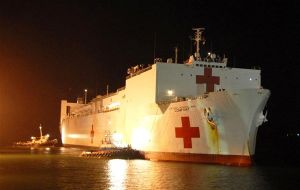MercoPress. South Atlantic News Agency
Aftershocks cause panic among Haitians and rescuers
 US Navy's floating hospital, USNS Comfort
US Navy's floating hospital, USNS Comfort A powerful aftershock sent Haitians screaming into the streets on Wednesday, collapsing buildings, cracking roads and adding to the trauma caused by the major quake eight days ago.
The magnitude-5.9 jolt matched the strongest of the aftershocks that have followed the huge quake of January 12 that devastated Haiti's capital.
The new temblor collapsed seven buildings in Petit-Goave, the seaside town closest to the epicentre, according to Mike Morton of the UN Disaster Assessment and Coordination agency, but there were no reports of people crushed or trapped, perhaps because the earlier quake frightened most people into sleeping outside.
Wails of terror erupted in Port-au-Prince, where the aftershock briefly interrupted rescue efforts amid the broken concrete of collapsed buildings, and prompted doctors and patients to flee the University Hospital.
Hundreds of thousands of Haitians remain homeless, hungry and in mourning, most still waiting for the benefits of a nearly one billion US dollars global aid campaign that has brought hundreds of doctors and thousands of troops to the impoverished nation.
The US Navy's floating hospital, USNS Comfort, dropped anchor in view of the capital on Wednesday with about 550 medical staff and 1.000 beds, joining teams from about 30 other countries trying to treat the injured. The Pentagon announced that 2,000 more US Marines would be sent to Haiti, adding 11,500 U.S. military personnel already on the ground or on ships offshore - a number expected to reach 16,000 by week's end.
The US Geological Survey said the aftershock was centred about 60 kilometres west-southwest of Port-au-Prince and 10 kilometres below the surface. It was a little further from the capital than last week's magnitude-7.0 quake, which killed an estimated 100.00/200,000 people and made as many as 2 million homeless, according to the European Union.
Wednesday's temblor matched the strongest of 49 aftershocks of magnitude-4.5 or greater that have followed the Jan. 12 quake and USGS geophysicist Bruce Pressgrave said nobody knows if a still-stronger aftershock is possible.
“Aftershocks sometimes die out very quickly,” he said. “In other cases they can go on for weeks, or if we're really unlucky it could go on for months” as the earth adjusts to the new stresses caused by the initial quake.
International aid teams have saved 121 people from the rubble, an unprecedented number, according to aid organization. Dr. Jon Kim Andrus, deputy director for the Pan American Health Organization, said that “countless more have been rescued by Haitians working with no equipment at all,” he said.
The World Food Program said it has distributed about 1 million food rations to 200,000 people around the capital - but that is just a tenth the number it hopes to reach.
Governments have pledged nearly one billion USD in aid, and thousands of tons of food and medical supplies have been shipped. But a significant percentage remains trapped in warehouses, or diverted to the neighbouring Dominican Republic. Port-au-Prince's non-functioning seaport and many impassable roads complicate efforts to get aid to the people.
Aid is still being turned back from the single-runway airport, where the U.S. military has been criticized by some of poorly prioritizing flights. The US Air Force said it had raised the facility's daily capacity from 30 flights before the quake to 180.




Top Comments
Disclaimer & comment rulesCommenting for this story is now closed.
If you have a Facebook account, become a fan and comment on our Facebook Page!